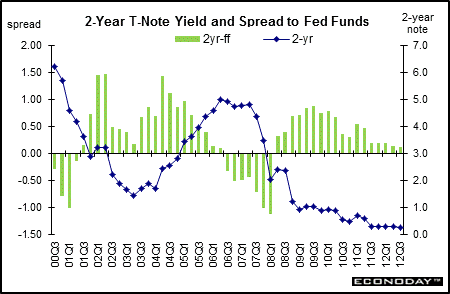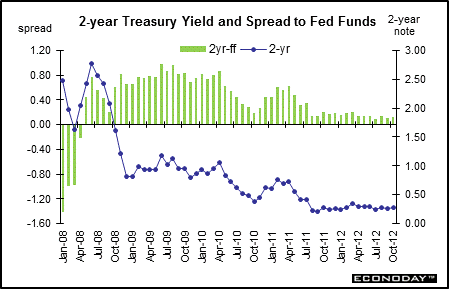 |

Often, one can get a sense of market expectations by looking at the spread between the 2-year note yield and the fed funds rate. When the spread narrows, or even turns negative, it means that market participants expect the Fed to ease monetary policy. When the spread widens, market participants are looking for tighter monetary policy. Since the start of the new millennium, the Fed has had sharp swings in policy. Early in the past decade the Fed was fighting recession and the possibility of deflation. Then the Fed went into tightening mode from mid-2004 until mid-2006. The spread fell sharply after 2004 – first as the fed funds rate rose faster than the two-year note and then during 2007 and into 2008 as the two-year-note dropped ahead of Fed rate cutting and due to flight to quality. Declines in the spread from August 2006 and into spring 2008 indicate that the markets expected lower interest rates in coming quarters. But during the remainder of 2008, the Fed cut the fed funds target so aggressively that fed funds finally fell below the 2-year T-note. More recently, the moderate-to-sluggish recovery in the U.S., recession in parts of Europe, worries over European sovereign debt, fiscal cliff concerns kept the 2-year T-note yield relatively low.

The spread between the 2-year note yield and the fed funds rate firmed in October to 12 basis points from 11 the month before. The 2-year note yield rose 2 basis points for the month to 0.28 percent while the effective fed funds rate nudged up 1 basis point to 0.16 percent on a monthly average basis. The effective fed funds rate is within the Fed’s target range of zero to 0.25 percent. The 2-year-note yield is low due to flight to safety on European sovereign debt concerns and expectations that the Fed will keep policy rates exceptionally low through at least mid-2015 as announced at the September 12-13, 2012 FOMC meeting and confirmed at the October 23-24, 2012 FOMC.



Production & Sales •
Inflation •
Federal Reserve Policy •
Interest Rates
|
 |